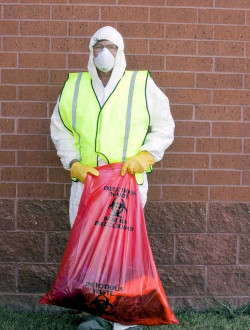Potentially Biohazardous Waste
It is of the utmost importance that infectious waste be safely contained.

- Infectious waste should be placed in specially designed containers constructed to contain the contents.
- The containers need to be leak-proof, labeled or color coded, and closed prior to removal to prevent spills.
- If a container is leaking, place it in a secondary leak-proof container.
Contaminated Laundry
"Contaminated laundry" refers to laundry that is soiled with potential infectious material or that may contain sharp objects, such as needles. When working with contaminated laundry, the following guidelines should be followed:
- Contaminated laundry should be handled as little as possible.
- Wear gloves when handling contaminated laundry, and place it in labeled, leak-proof bags or containers before transporting it.
- Never take contaminated protective clothing home for laundering, even if it is personal clothing.
- Pick up potentially contaminated broken glassware using mechanical means only, such as tongs, forceps, or brush and dustpan.
Work practice controls should be established to prevent you from reaching into a container to remove potentially contaminated items, such as glassware or needles.
- All equipment and work surfaces that could become contaminated should be cleaned and decontaminated routinely using an appropriate disinfectant while wearing PPE.
- All pails, bins, and similar reusable receptacles should be decontaminated on a regular basis and as soon as possible after visible contamination is noticed.
Knowledge Check Choose the best answer for the question.
1-10. Which method would you use to pick up potentially contaminated broken glassware?
You forgot to answer the question!
